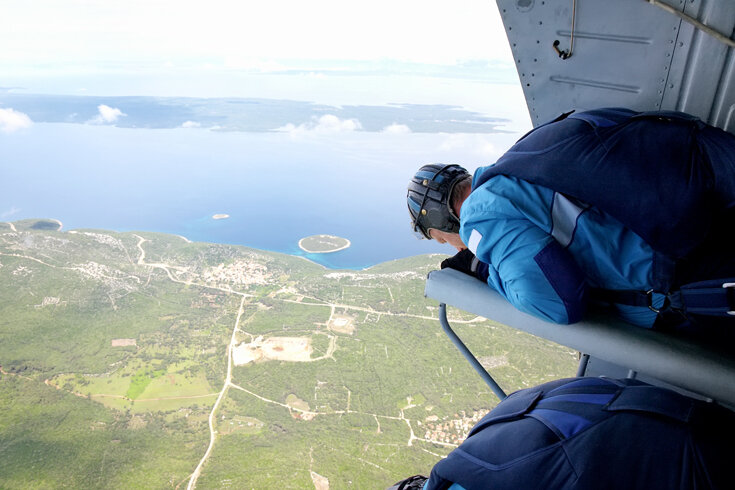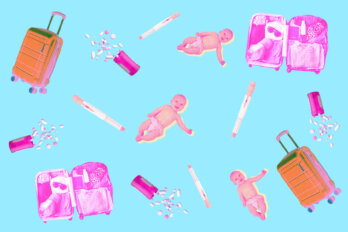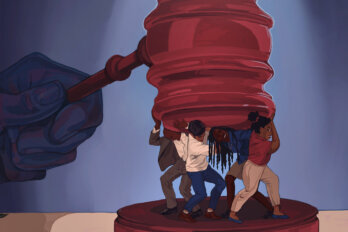“You’re going to feel pretty bad if your son dies! You’re going to feel horrible!”
This was my sister-in-law’s mic-drop retort in an intense debate we were having about risk. It happened at a family Sunday dinner. I had just told the collected kinfolk that I had decided to go skydiving. Ten thousand feet, mostly free fall.
Everyone thought I was crazy. I am pretty sure most of them entertain this sentiment on a fairly regular basis, so the thought of Uncle Tim plummeting to the earth at terminal velocity wasn’t what ignited the debate. What really upped the family angst was that I planned to take my fourteen-year-old son, Michael.
We make a ridiculous number of decisions every day. According to some estimates, the number hovers in the thousands. And, if we are asked about why we made a particular decision, most of us will muster some relatively coherent rationale. We select a particular food because we believe it is healthier or better for the environment. We brush and floss our teeth because we don’t want them to fall out. We say no to another cup of coffee because too much caffeine may be bad for us. We drive our kids to school because we worry about their safety. We avoid sitting on public toilet seats so we won’t pick up germs. We take a nap in the afternoon because we’ve been told it will boost our productivity. We try not to obsessively check our email as we’ve been told doing so will stress us out. We stand because sitting is the new smoking. We take vitamins because we want to stave off disease.
But many of these rationales and beliefs do not fit with the evidence. From the moment we wake to the moment we drift off to sleep at night, we make dozens and dozens of decisions that are based, to lesser or greater extents, on misinformation. Finding a path to the objective truth on any topic, from toothpaste to toilet seats to, yes, skydiving, can be difficult. But the path does exist, and finding it can be liberating.
Innumerable cultural, social, and psychological forces shape the decisions we make. And our rationales for a decision are often tacked onto our actions after we have made our decision. That is, we make a decision first and then, consciously or unconsciously, we construct reasons why it was the correct one, reasons that fit the decision, our personal identity, or our desire to be seen as consistent or logical—even if the original motive for the decision may have been different or even unknown to us.
We do this is as a way to avoid what is called post-decision dissonance. Studies have found that, after choosing, for example, a new job or which university to attend, people will rank the attributes of their chosen institution higher than they did before making their decision and—no surprise—rank the attributes of the loser lower. In addition, we make decisions that allow us to feel we are being consistent. So past decisions shape future decisions. For instance, perhaps you bought GMO-free food because you already buy organic food and that seemed like a consistent pattern and fit with your personal image. You then need a rationale to justify this decision even though what influenced your food choice was simply the drive to be consistent. And, once the decision is made, you must become more committed to the rationale because now it is part of how you perceive yourself.
Exploring the deep disconnect between the rationales and beliefs behind our decisions and what the actual science says provides an opportunity to dive into three harmful, and increasingly pervasive, social paradoxes. Indeed, I believe these paradoxes have become significant and less than laudable hallmarks of our time. And all three make decision making more difficult and infinitely more stressful.
First, there is the perfection paradox. We are under increasing pressure to improve ourselves and continually strive toward perfection—in our appearances, careers, relationships, parenting, mental health, sex lives, you name it. Recent research, including a large 2017 analysis of more than 40,000 college students, has found that both perfectionist attitudes and perfectionist social pressures have increased markedly over the past decades. The paradox is that, in general, neither the journey toward perfection nor the attainment of a perfection-oriented goal confers greater happiness, at least in the long term. To cite just one example, new social media apps allow anyone to alter and perfect how they look online. This has resulted in completely unrealistic standards of beauty. Celebrities and models have long been airbrushed and photoshopped. Now, everyone can tweak their images. To make matters worse, social media and mobile devices create the opportunity for near-constant social comparison, something that leaves many of us miserable, anxious, and dissatisfied.
Some of the increasing social pressures to self-improve come from the entities marketing products to help us in that quest. Not only are these perfection-seeking decisions often pointless, the associated decisions—about, say, what supplement to take or self-help strategy to employ—are not informed by science. When this happens, it is a triple-whamming waste of your time, energy, and (often) money.
Second, there is the knowledge-era paradox. We live in a world awash in information. There has never been as much science-informed knowledge as there is now. It has been estimated that the global scientific output doubles every nine years. Since 1665, when the first academic journals were produced in France and Britain, more than 50 million scholarly articles have been published. And approximately 2.5 million new scientific papers are published each year. Not all of these papers are useful to our day-to-day decision making, of course, but these numbers give a sense of the growth and quantity of scientific inquiry.
However, there has also been a growth in the number and sway of social forces perverting that knowledge. This is the era of fake news, conspiracy theories, alternative facts, and social media confirmation bubbles. Too often, information is twisted, hyped, misrepresented, or overtly misinterpreted. So, in fact, more and more-available information often does not lead to more-informed decisions.
Finally, the third paradox that makes decision making more difficult and more stressful is the less-risk paradox. A lot of the decisions we make are to some degree about avoiding harm or minimizing risk. And advertisers know this. Fearmongering has become a dominant theme in the marketing of products and ideas, particularly in the context of health. The multitrillion-dollar wellness industry creates a reason to be fearful—such as the need to avoid toxins—and then markets a solution to that manufactured fear.
Entire industries are dedicated to the goal of keeping our kids safe. There are monitoring devices aimed at stopping stranger-danger abductions and merchandise to reduce your child’s exposure to the myriad chemical substances that are, or so the marketing tells us, threatening their health. Jessica Alba’s The Honest Co, valued at over $1 billion (US), appears to have been founded on the philosophy that fear (plus parental guilt) sells: the company markets things like diapers (made with naturally derived materials, of course), vitamins (organic and non-GMO, clearly), and cleaning products (hypoallergenic, obviously) based on its stated philosophy of providing “peace of mind” because “protecting you and the ones you love” is the company’s top priority.
Yes, we need to be vigilant about potentially dangerous substances in our environment. But we are not living in some dystopian Mad Max world awash in toxic chemicals that will melt our skin and mutate our DNA. In fact, in most countries, this is the safest and healthiest time to be alive, even if we’re not convinced of that. By almost any objective measure, things are better now than ever before. In the US, for example, both violent crime and property crime rates have fallen steadily and significantly over the past quarter century. Yet, in 2017, almost 70 percent of Americans thought there was more crime than a year before. Only 19 percent got it correct: there was less.
Teenage pregnancy has declined. There are fewer missing children. Illicit drug use by teenagers has declined. Binge drinking and cigarette smoking are far less common than they were a few decades ago. And fewer child pedestrians are being hit by cars even though there are more people, and more people driving more kilometres, than ever before. (In 2017, Americans drove a record 5.18 trillion kilometres.) It is now safer for your child to cross the street than it was when you were a kid yourself. Data from the US National Highway Traffic Safety Administration shows that, since 1993, the number of children being struck and killed by cars each year has declined from over 800 to fewer than 250.
It is the same with many diseases too. While we still need to take account of the tremendous and horrific impact of the COVID-19 pandemic, until last year, fewer and fewer people died of infectious diseases, thanks largely to vaccination—an invention that saves millions of lives every year. Even with cancer, we often overestimate the actual risks and place blame in the wrong places (Wi-Fi, stress, GMOs). Although cancer remains a leading cause of death, second only to heart disease, here, too, things are improving. In 2018, the US National Cancer Institute reported that, between 1990 and 2014, the overall cancer death rate had declined by 25 percent. Globally, life expectancy is up 5.5 years since 2000.
It is important to recognize progress. Yet few of us do. A 2015 survey found that only 6 percent of Americans think the world is getting better. The bottom line is that we live in an era of unprecedentedly low levels of health and safety risk, yet we are, paradoxically, increasingly preoccupied with the elimination of risk, both real and imagined.
We should, of course, continually strive to improve things, such as the livability of our neighbourhoods, the safety of our streets, access to healthy food choices, and the cleanliness of our air and water. And we are facing tremendous challenges, including climate change, eroding biodiversity, climbing obesity rates, mental health concerns, antimicrobial resistance, continued global conflicts, and less than ideal levels of social tolerance and diversity, just to name a few. So I’m not arguing that things are perfect—only that we need to keep things in perspective.
My wife, Joanne, was not pleased. “I don’t mind if you go, but do you need to take Michael?”
Everyone I told about my skydiving experiment agreed with Joanne. The consensus was that I was crazy to involve my son, that this was a very bad and irresponsible parenting decision. Michael, however, couldn’t wait. He located the best local skydiving outfit to provide the death-defying service and nagged me constantly to make a reservation. “The weather looks pretty good this weekend, Dad. We better book a spot,” he’d say several times a day.
I’m not saying skydiving is a good idea. In fact, it terrifies me. I was absolutely horrified by the notion of throwing myself out of a plane—let alone my youngest son jumping alongside me. I hate flying in small planes: they tend to make me vomit. And I am not, by any measure, a particularly brave individual. I’m the kind of person who, at the sight of a black bear, bolts and leaves his beautiful young bride to be eaten. In fact, that is precisely what I did when, early in our marriage, my wife and I came across a black bear. But these are the exact reasons I decided to go skydiving. Despite my genuine fear, I knew it was a relatively safe activity.
How safe? According to the United States Parachute Association, there are an estimated 3 million jumps each year. The fatality count, per year, hovers around twenty. That is a 0.007 percent chance of a death for every 1,000 jumps. That is a very, very small risk. It was way more dangerous driving to the jump site (or, for that matter, to the corner store). With tandem jumping—which is when you are strapped to an expert and what beginners like Michael and I would do—the fatality rate is even lower. According to the British Parachute Association, “The all-time tandem fatality rate since 1988 is about 0.14 per 100,000 jumps.” Put another way: one in 703,000. This is a very, very, very small risk. And, in the UK, there have been zero tandem fatalities in the past twenty years. The injury rate for skydiving, which is defined as everything from a minor scratch to fractures and sprains, is also remarkably low, at about one in 1,100 jumps.
Michael is a competitive gymnast. He’s at the level where he does swings on the top of the high bar, iron crosses, twisting dismounts off the rings, and spinning flips on the floor and vault. His chances of a serious injury in this sport, if you believe the research, are more than ten times greater than the risk of getting even a minor scratch skydiving. But none of the people who scolded me about my skydiving decision have ever warned me off gymnastics. Some of the scolders have kids who play hockey, an activity that seems more dangerous than either skydiving or gymnastics: one study found that there are approximately nineteen injuries (defined as fairly serious things like concussions and ligament damage) per 1,000 games played.
Again, the point is not that gymnastics or hockey or driving are bad decisions as compared to jumping out of a plane, but these comparisons do show how we all weigh and think about risks in weird and complex ways, especially when our kids are involved.
And, by the way, being killed by a bear is also a pretty remote danger. Between 1900 and 2009, there were sixty-three fatal bear attacks in North America. If you think of the millions and millions of individuals exposed to bear habitats over that period, it gives you a sense of how small the risk actually is. But, when a bear attack does occur, it is almost always big news, generating headlines, TV coverage, and follow-up personal-interest stories on the attacked people and the community.
When an event produces a particularly strong emotional response, we tend to emphasize the risks associated with it. It is easier to picture a gruesome bear mauling or a skydiving accident than, say, the well-documented ill effects of not eating enough fruits and vegetables or not getting enough sleep.
The good news is that, for many of the decisions we make hour to hour and day to day, we can turn to science. If we know what to look for, we can make evidence-informed choices.
The airplane was tiny and old, a Cessna from the 1950s. It was also extremely loud. The seats had been removed, and Michael and I were jammed into a space right behind the pilot. It was so cramped I couldn’t sit up or straighten my legs. Waves of claustrophobia simmered in the back of my skull.
The plane groaned and shuddered as it climbed to the prescribed altitude. It felt like we were in a flying lawnmower. It felt like this had been a very bad decision.
When we got to 12,000 feet, the engine slowed and the pilot flung the door open. There was a roar of wind and even more noise. Michael and I locked eyes. “Holy shit,” he reflexively mouthed, a huge smile on his face.
Michael and the instructor inched their way to the door. Michael put his feet out of the plane, and before I could process what was happening, he was gone. My stomach churned as I saw my son fall, in what seemed like an instant, to the size of a small dot.
What the hell had I been thinking?
Then it was my turn. Without thinking—because that would result in a cowardly retreat—I placed my feet on a little platform outside the plane. The wind was intense. I found it hard to breathe. We tumbled out of the plane.
“Ahhhhhhh!” I screamed uncontrollably. “Amazing! This is amazing!”
Excerpted from Relax, Dammit!: A User’s Guide to the Age of Anxiety by Timothy Caulfield. Copyright © 2020 Timothy Caulfield. Published by Penguin Canada, a division of Penguin Random House Canada Limited. Reproduced by arrangement with the publisher. All rights reserved.





